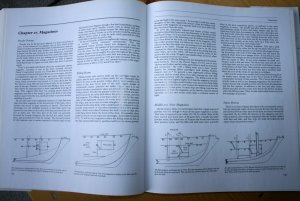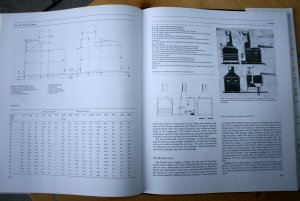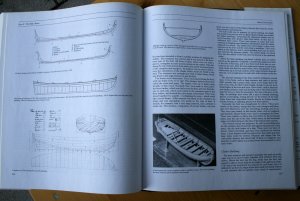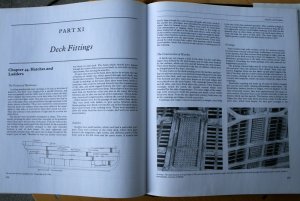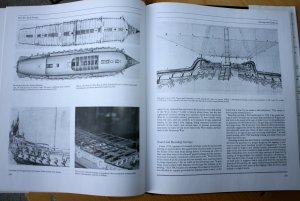Arming and Fitting of English Ships of War 1600-1815
by Brian Lavery
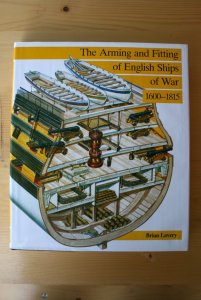
Synopsis:
The Royal Navy armed and fitted out thousands of wooden warships between 1600 and 1815, and virtually every item or process was the subject of alteration or improvement during this period. This book sets out the precise nature of these developments with exact information on sizes and scantlings, based on reliable contemporary sources. This makes the book an indispensable guide to all historical ship modellers, but it also provides a wider analysis of technological development which will be of great value to maritime historians and industrial archeologists,
This book completes the detailed technical coverage of the wooden warship begun by James Lees` "Masting and Rigging" and Peter Goodwin´s "Sailing Man of War"
The Whipstaff, steering wheel
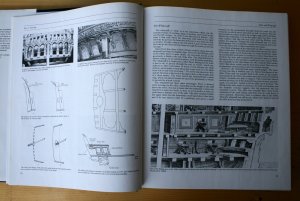

Content:
Part I: STEERING (page 9 to 29)
Rudders - Tiller and Whipstaff - The Steering Wheel - Navigational Fittings
Part II: ANCHORS and CAPSTANS (page 30 to 55)
 s - Capstans - Cables and Accessories -
s - Capstans - Cables and Accessories -  Tackle
Tackle
Part III: UNDERWATER PROTECTION (page 56 to 65)
Graving and Paying - Wood and Lead Sheathing - Copper Sheathing
Part IV: PUMPS (page 66 to 79)
Pumps and Drainage - The Improved Chain Pump, and the Brake Pump
Part V: GUNS (page 80 to 109)
The Supply of Guns - Materials: Brass and Iron - The Shape of Guns - The Proportion of Guns - Types of Guns - Carronades
Part VI: THE DISTRIBUTION OF GUNS (page 110 to 125)
Early Armaments - The Establishments - Types of Ship - The Age of the Carronade
Part VII: GUN EQUIPMENT (page 126 to 150)
Gun Carriages - Powder, Shot and Stores - Gun Tackle and Equipment - Magazines
Part VII: ACCOMODATION (page 151 to 185)
General Layout - The Layout of Cabins - Captains and Admirals - The Structure and Fitting of Cabins - Hammocks - The Messes
Part IX: INTERNAL FITTINGS (page 186 to 206)
Hold Stowage - Store Rooms - Cooking - Sanitary and Medical Arrangements
Part X: THE SHIP`S BOATS (page 207 to 237)
The Uses of Boats - Boat Construction - Types of Boat - Boat Fittings - Boat Establishment - Boat Stowage
Part XI: DECK FITTINGS (page 238 to 256)
Hatches and Ladders - Rails and Nettings - Awnings and Gangways - Communication
APPENDICES (page 257 to 300)
Notes, Bibliography, Index
Everything about different types and sizes af anchors, types, numbers and locations of the capstan on different types of ships

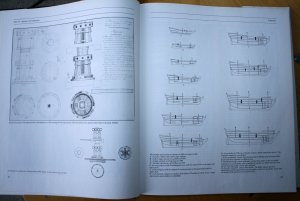
Review:
This book is a real fitting companion to James Lee´s "The Masting and Rigging of English Ships of War, 1625-1860" and also to Goodwin´s book "The Construction and Fitting of the Sailing Man-of-War, 1650-1850". If you have these three books in your library, you will have a very good overview of the most important technical details of this time of the british Man of War.
It's written in much the same vein, and has some very good insights on the actual fitting out and arming of these ships.
There is nothing on Rigging in it - in fact the author points out that this is covered adequately in books like Mr. Lees'.
Lots of good line drawings, prints of old engravings and drawings and photos of models of the era covered are accompanied by a comprehensive and very good understandable text.
One of the "must haves" and highly recommended
 tackle, stoppers, cathead, cat tackle, copper sheathing, Coppering techniques
tackle, stoppers, cathead, cat tackle, copper sheathing, Coppering techniques
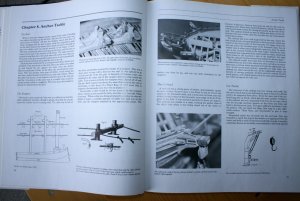
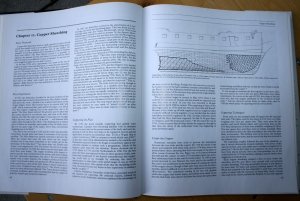
pumps, drainage of the hold, chain pump, pumps for washing the deck etc.


Some more Look Inside photos of Brian Lavery ´s book "The Arming and Fitting of English Ships of War, 1600-1815" you can find in the next post
by Brian Lavery

- Hardcover: 319 pages
- Publisher: Naval Inst Pr; 1st Edition edition (March 1, 1988)
- Language: English
- ISBN-10: 0870210092
- ISBN-13: 978-0870210099
- Product Dimensions: 10.2 x 1 x 12 inches
- Shipping Weight: 3.9 pounds
Synopsis:
The Royal Navy armed and fitted out thousands of wooden warships between 1600 and 1815, and virtually every item or process was the subject of alteration or improvement during this period. This book sets out the precise nature of these developments with exact information on sizes and scantlings, based on reliable contemporary sources. This makes the book an indispensable guide to all historical ship modellers, but it also provides a wider analysis of technological development which will be of great value to maritime historians and industrial archeologists,
This book completes the detailed technical coverage of the wooden warship begun by James Lees` "Masting and Rigging" and Peter Goodwin´s "Sailing Man of War"
The Whipstaff, steering wheel


Content:
Part I: STEERING (page 9 to 29)
Rudders - Tiller and Whipstaff - The Steering Wheel - Navigational Fittings
Part II: ANCHORS and CAPSTANS (page 30 to 55)
 s - Capstans - Cables and Accessories -
s - Capstans - Cables and Accessories -  Tackle
TacklePart III: UNDERWATER PROTECTION (page 56 to 65)
Graving and Paying - Wood and Lead Sheathing - Copper Sheathing
Part IV: PUMPS (page 66 to 79)
Pumps and Drainage - The Improved Chain Pump, and the Brake Pump
Part V: GUNS (page 80 to 109)
The Supply of Guns - Materials: Brass and Iron - The Shape of Guns - The Proportion of Guns - Types of Guns - Carronades
Part VI: THE DISTRIBUTION OF GUNS (page 110 to 125)
Early Armaments - The Establishments - Types of Ship - The Age of the Carronade
Part VII: GUN EQUIPMENT (page 126 to 150)
Gun Carriages - Powder, Shot and Stores - Gun Tackle and Equipment - Magazines
Part VII: ACCOMODATION (page 151 to 185)
General Layout - The Layout of Cabins - Captains and Admirals - The Structure and Fitting of Cabins - Hammocks - The Messes
Part IX: INTERNAL FITTINGS (page 186 to 206)
Hold Stowage - Store Rooms - Cooking - Sanitary and Medical Arrangements
Part X: THE SHIP`S BOATS (page 207 to 237)
The Uses of Boats - Boat Construction - Types of Boat - Boat Fittings - Boat Establishment - Boat Stowage
Part XI: DECK FITTINGS (page 238 to 256)
Hatches and Ladders - Rails and Nettings - Awnings and Gangways - Communication
APPENDICES (page 257 to 300)
Notes, Bibliography, Index
Everything about different types and sizes af anchors, types, numbers and locations of the capstan on different types of ships


Review:
This book is a real fitting companion to James Lee´s "The Masting and Rigging of English Ships of War, 1625-1860" and also to Goodwin´s book "The Construction and Fitting of the Sailing Man-of-War, 1650-1850". If you have these three books in your library, you will have a very good overview of the most important technical details of this time of the british Man of War.
It's written in much the same vein, and has some very good insights on the actual fitting out and arming of these ships.
There is nothing on Rigging in it - in fact the author points out that this is covered adequately in books like Mr. Lees'.
Lots of good line drawings, prints of old engravings and drawings and photos of models of the era covered are accompanied by a comprehensive and very good understandable text.
One of the "must haves" and highly recommended
 tackle, stoppers, cathead, cat tackle, copper sheathing, Coppering techniques
tackle, stoppers, cathead, cat tackle, copper sheathing, Coppering techniques

pumps, drainage of the hold, chain pump, pumps for washing the deck etc.


Some more Look Inside photos of Brian Lavery ´s book "The Arming and Fitting of English Ships of War, 1600-1815" you can find in the next post
Last edited by a moderator:





